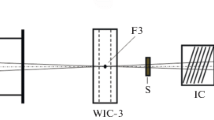Abstract
The irradiation of brain structures with accelerated heavy charged particles during interplanetary flights or brain tumor therapy raises a number of questions regarding possible neurophysiological disorders in the central nervous system (CNS). Hardly repairable clustered DNA double-strand breaks apparently can have significant influence on the specifics of the development of radiation syndromes in the CNS after heavy charged particle exposure. The mechanisms of these disorders still remain unclear. Taking this into account, we have used immune cyto- and histochemistry techniques to study regularities of the formation of radiationinduced foci in human cell DNA in vitro and in rodent brain neurons in vivo after exposure to charged particles of different energies. It has been found that heavy charged particles induce clustered DNA damage in the genome of proliferating (human fibroblasts) and non-proliferating (Purkinje neurons) cells. We have suggested that changes in genetic structures can affect the conformation of the key proteins participating in neurophysiological processes and violate the normal functioning of the synaptic receptors. As an example, we have considered the action of double point mutations in the gene sequence encoding the proteins of the glutamate receptor NMDA. Using computer molecular dynamics techniques, we have revealed a twofold change in the conductance of the receptor’s ion channel, which incorporates mutant forms of the protein subunits NR2.
Similar content being viewed by others
References
D. T. Goodhead, “Initial events in the cellular effects of ionizing radiations: clustered damage in DNA,” Int. J. Radiat. Biol. 65, 7–17 (1994).
E. Sage and N. Shikazono, “Radiation-induced clustered DNA lesions: repair and mutagenesis,” Free Radic. Biol. Med. 107, 125–135 (2016).
L. Jezkova, M. Zadneprianetc, E. Kulikova, E. Smirnova, T. Bulanova, D. Depes, I. Falkova, A. Boreyko, E. Krasavin, M. Davidkova, S. Kozubek, O. Valentova, and M. Falk, “Particles with similar LET values generate DNA breaks of different complexity and reparability: a high-resolution microscopy analysis of γH2AX/53BP1 foci,” Nanoscale, 10, 1162–1179 (2018).
R. A. Britten, L. K. Davis, A. M. Johnson, S. Keeney, A. Siegel, L. D. Sanford, S. J. Singletary, and G. Lonart, “Low (20 cGy) doses of 1 GeV/u 56Fe-particle radiation lead to a persistent reduction in the spatial learning ability of rats,” Radiat. Res. 177, 146–151 (2012).
A. A. Besbach, V. B. Zager, G. Kaminski, A. I. Krylov, V. A. Krylov, Y. G. Teterev, and G. N. Timoshenko, “Upgrade of the “Genome” facility for radiobiological experiments at heavy ion beams,” Phys. Part. Nucl. Lett. 10, 175–178 (2013).
M. Kozubek, P. Matula, P. Matula, and S. Kozubek, “Automated acquisition and processing of multidimensional image data in confocal in vivo microscopy,” Microsc. Res. Tech. 64, 164–175 (2004).
UCSC Genome Browser Gateway. http://genome.ucsc.edu/cgi-bin/hgGateway?redirect=manual&source=genome.ucsc.edu.
N. Tajima, E. Karakas, T. Grant, N. Simorowski, R. Diaz-Avalos, N. Grigorieff, and H. Furukawa, “Activation of NMDA receptors and the mechanism of inhibition by ifenprodil,” Nature (London, U.K.) 534, 63–68 (2016).
A. Sali and T. L. Blundell, “Comparative protein modelling by satisfaction of spatial restraints,” J. Mol. Biol. 234, 779–815 (1993).
J. Dai and H. Xi. Zhou, “An NMDA receptor gating mechanism developed from MD simulations reveals molecular details underlying subunit-specific contributions,” Biophys. J. 104, 2170–2181 (2013).
H. Dong and H. X. Zhou, “Atomistic mechanism for the activation and desensitization of an AMPA-subtype glutamate receptor,” Nat. Commun. 2, 354 (2011).
J. C. Phillips, R. Braun, W. Wang, J. Gumbart, E. Tajkhorshid, E. Villa, C. Chipot, R. D. Skeel, L. Kalé, and K. Schulten, “Scalable molecular dynamics with NAMD,” J. Comput. Chem. 26, 1781–1802 (2005).
N. Burnashev and P. Szepetowski, “NMDA receptor subunit mutations in neurodevelopmental disorders,” Curr. Opin. Pharmacol. 20, 73–82 (2015).
Solvate. Max Plank Institute for Biophysical Chemistry. www.mpibpc.mpg.de/grubmueller/solvate.
W. Humphrey, A. Dalke, and K. Schulten, “VMD— visual molecular dynamics,” J. Mol. Graph. 14, 33–38 (1996).
O. S. Smart, J. G. Neduvelil, X. Wang, B. A. Wallace, and M. S. Sansom, “HOLE: a program for the analysis of the pore dimensions of ion channel structural models,” J. Mol. Graph. 14, 354–360 (1996).
L. Shi, M. M. Adams, A. Long, C. C. Carter, C. Bennett, W. E. Sonntag, M. M. Nicolle, M. Robbins, R. D’Agostino, and J. K. Brunso-Bechtold, “Spatial learning and memory deficits after whole-brain irradiation are associated with changes in NMDA receptor subunits in the hippocampus,” Radiat. Res. 166, 892–899 (2006).
M. Machida, G. Lonart, and R. A. Britten, “Low (60 cGy) doses of (56)Fe HZE-particle radiation lead to a persistent reduction in the glutamatergic readily releasable pool in rat hippocampal synaptosomes,” Radiat. Res. 174, 618–623 (2010).
R. Madabhushi, F. Gao, A. R. Pfenning, L. Pan, S. Yamakawa, J. Seo, R. Rueda, T. X. Phan, H. Yamakawa, P. C. Pao, R. T. Stott, E. Gjoneska, A. Nott, S. Cho, M. Kellis, and L. H. Tsai, “Activityinduced DNA breaks govern the expression of neuronal early-response genes,” Cell 161, 1592–1605 (2015).
Y. Suzuki, T. A. Goetze, and J. M. Edwardson, “Visualization of structural changes accompanying activation of n-methyl-d-aspartate (NMDA) receptors using fastscan atomic force microscopy imaging,” J. Biol. Chem. 288, 778–784 (2013).
Author information
Authors and Affiliations
Corresponding author
Additional information
The article is published in the original.
Rights and permissions
About this article
Cite this article
Boreyko, A.V., Bugay, A.N., Bulanova, T.S. et al. Clustered DNA Double-Strand Breaks and Neuroradiobiological Effects of Accelerated Charged Particles. Phys. Part. Nuclei Lett. 15, 551–561 (2018). https://doi.org/10.1134/S1547477118050035
Received:
Published:
Issue Date:
DOI: https://doi.org/10.1134/S1547477118050035



